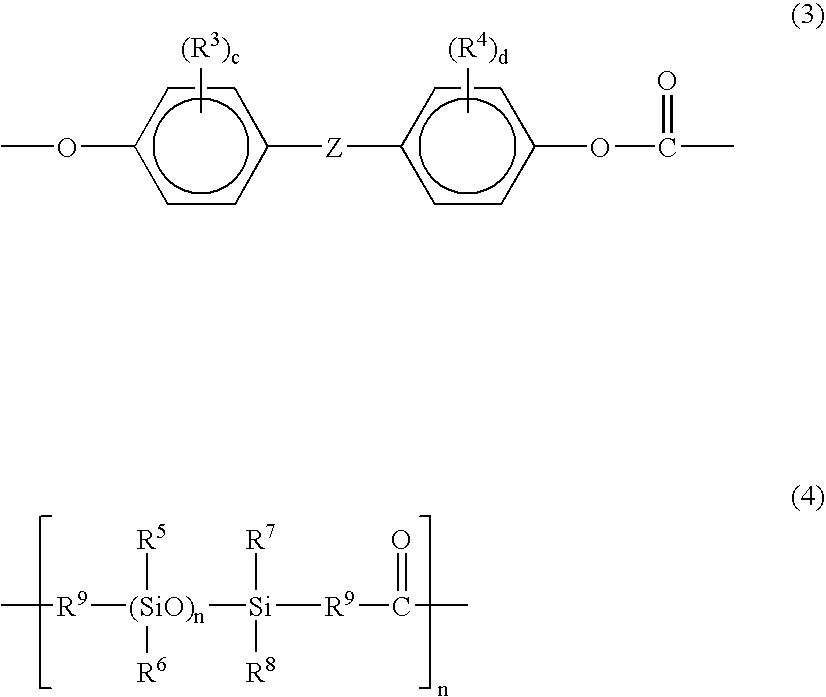Thermoplastic resin and formed product
a technology of thermoplastic resin and formed products, which is applied in the direction of transportation and packaging, tyre parts, special tyres, etc., can solve the problems of poor thermal stability, inability to disperse enough fumed silica, and drop of polycarbonate-based resin melt, etc., to achieve sufficient flame retardancy, excellent impact strength, and sufficient flame retardancy
- Summary
- Abstract
- Description
- Claims
- Application Information
AI Technical Summary
Benefits of technology
Problems solved by technology
Method used
Image
Examples
preparation example 1
Production of Aromatic Polycarbonate (PC)-Polyorganosiloxane (PDMS) Copolymer
(1) Production of PC Oligomer
[0067]In 400 liters of a 5 mass % aqueous sodium hydroxide solution were dissolved 60 kg of bisphenol A to obtain an aqueous sodium hydroxide solution of bisphenol A. Then, the aqueous sodium hydroxide solution of bisphenol A maintained at room temperature and methylene chloride were introduced through an orifice plate at flow rates of 138 liter / hour and 69 liter / hour, respectively, into a tubular reactor having an inside diameter of 10 mm and a tube length of 10 m, into which phosgene was co-currently blown at a flow rate of 10.7 kg / hour so that the reaction was continuously carried out for 3 hours. The tubular reactor used herein was a double-walled tube, and cooling water was passed through a jacket part so that the temperature of the reaction liquid discharged therefrom was maintained at 25° C. The pH of the discharged liquid was adjusted to 10 to 11.
[0068]The thus obtained ...
preparation example 2
Production of Alkylphenoxy-Terminated Aromatic Polycarbonate Resin
(1) Preparation of Alkylphenol (a)
[0078]In a reactor equipped with a baffle and a stirring blade, reaction raw materials and a catalyst were charge in such a proportion that the amount of phenol was 300 mass parts, the amount of 1-dococene was 110 mass parts (phenol / olefin molar ratio=9:1) and the amount of a highly acidic polystyrene-based sulfonic acid-type cationic resin (Amberlyst 15; manufactured by Rohm and Haas) as the catalyst was 11 mass parts. The mixture was reacted at 120° C. for 3 hours with stirring. After completion of the reaction, purification by vacuum distillation was performed to obtain alkylphenol (a). The alkyl group of alkylphenol (a) was found to have an average carbon number of 22 and to be branched.
(2) Production of Terminus-modified PC
[0079]In a vessel having an inside volume of 50 liters and equipped with a stirrer, 10 liters of a polycarbonate oligomer obtained in the same manner as descri...
PUM
| Property | Measurement | Unit |
|---|---|---|
| mass % | aaaaa | aaaaa |
| particle diameter | aaaaa | aaaaa |
| mass % | aaaaa | aaaaa |
Abstract
Description
Claims
Application Information
 Login to View More
Login to View More - R&D
- Intellectual Property
- Life Sciences
- Materials
- Tech Scout
- Unparalleled Data Quality
- Higher Quality Content
- 60% Fewer Hallucinations
Browse by: Latest US Patents, China's latest patents, Technical Efficacy Thesaurus, Application Domain, Technology Topic, Popular Technical Reports.
© 2025 PatSnap. All rights reserved.Legal|Privacy policy|Modern Slavery Act Transparency Statement|Sitemap|About US| Contact US: help@patsnap.com



